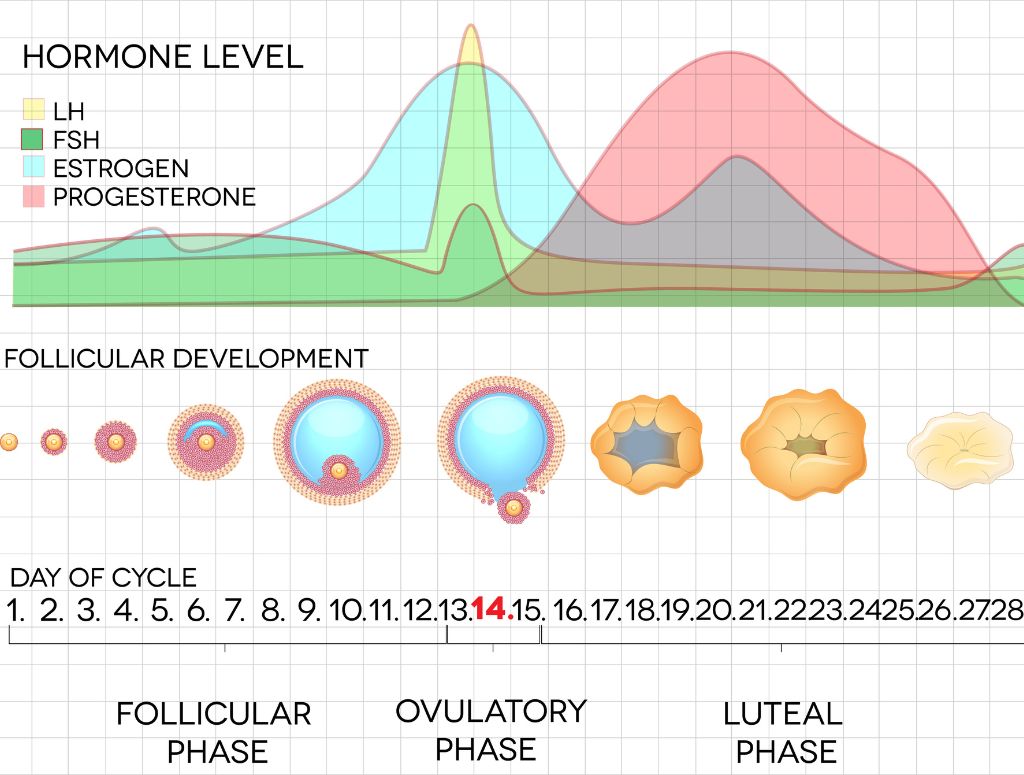Navigating the Menstrual Cycle as a Female Soccer Player

Table of Contents
Kickoff
Elevate your performance as a female soccer player by comprehensively understanding your menstrual cycle. Our in-depth guide provides insight into the influence of your cycle on elements such as injury risk and energy levels.
Discover the significant role of innovative menstruation apps, and delve into nutritional considerations and emotional factors closely associated with your cycle.
We also review the process of managing menstrual disorders and fostering a supportive team environment.
Additionally, we address the broader societal attitudes surrounding menstruation in sports, transcending the discussion beyond mere physical aspects.
Our goal is to empower your athletic prowess by helping you embrace these unique experiences. Your journey towards improved performance starts here. Are you ready to begin?

Understanding Injury Risks in Relation to Menstrual Cycle
Understanding the links between hormonal fluctuations during menstrual cycles and injury risks is a game-changer for female soccer players. As we explore these ten topics, we’ll uncover how to navigate these changes, enhancing your athletic performance while prioritizing your health. Get ready to empower your game by understanding your body’s unique rhythms.
1. Navigating Hormonal Fluctuations and Injury Risk: Your menstrual cycle could influence injury susceptibility, as estrogen levels affect tissue elasticity. Keep track of your cycle to identify your “risk” phases and adjust your training accordingly.
2. Estrogen’s Impact on Ligament Health: High estrogen levels, typically in the pre-ovulatory phase, can increase ligament laxity, potentially heightening joint injury risk. Modifying high-risk activities during this time could prevent injuries.
3. The ACL Tear Puzzle: ACL injuries are more common during the pre-ovulatory phase due to peak estrogen levels. Incorporating exercises like squats and lunges into your routine can strengthen the muscles supporting the ACL, reducing injury risks.
4. Progesterone’s Role in Muscle Recovery: Progesterone peaks during the luteal phase, potentially slowing muscle recovery and increasing injury risk. Lighter, restorative workouts during this phase might be a smart approach to prevent strain.
5. Hormonal Changes and Athletic Performance: Hormonal fluctuations can affect your reaction times and coordination. Concentrating on precision drills can help maintain performance levels when you notice slower reactions.
6. The Power of Cycle Monitoring: Regularly tracking your menstrual cycle can help identify patterns, allowing you to adjust your training regime effectively to prevent injury risks.
7. Adjusting Training Protocols: Knowledge of your cycle allows you to tailor training and recovery. During high-risk periods, lower-intensity training, along with ample recovery time, can reduce injury chances.
8. Preventive Exercise as a Key Strategy: Balance and stability exercises, like Pilates or yoga, can help manage injury risks associated with menstrual cycles. Regular practice can enhance body control, which is particularly useful during high estrogen phases.
9. The Necessity for Personalization: Hormonal responses vary among individuals. Understanding your unique reactions to different training loads throughout your cycle is vital, allowing for a more personalized training strategy.
10. The Indispensability of Professional Guidance: Given the complex relationship between menstrual cycles and injury risk, professional guidance from sports physicians or physiotherapists is essential. Their expert advice can help tailor an approach unique to your physiological responses.
More Information: Why helping to prevent ACL injuries is an open goal for brands

The Rise of Menstruation Apps
In the digital age, menstruation apps have emerged as valuable tools. These apps can help female soccer players manage their menstrual cycles effectively.
1. Leveraging Menstruation Apps for Performance Predictions: Utilize menstruation apps to forecast your physical and emotional responses during different phases of your cycle. Be better prepared for your training and matches.
2. Identifying Personalized Health Patterns: Advanced apps like Clue and Flo can highlight your unique health patterns, allowing you to tailor your training regimen effectively and optimize your performance throughout your cycle.
3. Enhancing Recovery with Menstruation Apps: Use personalized health insights and advice provided by menstruation apps to manage potential symptoms and aid in recovery better.
4. Menstrual Health Discussions with Coaches and Medical Professionals: Share your menstrual data with your coach or medical professional for comprehensive discussions on menstrual health. Foster an open conversation to understand your needs better.
5. Empowering Female Soccer Players Through Menstruation Apps: Embrace the uniqueness of your menstrual cycle. Leverage the power of menstruation apps to optimize your performance, both on and off the pitch.
Nutritional Considerations and Menstruation
In the world of sports, performance is often linked to diet and physical regimen. However, as a female athlete, another crucial aspect to consider is the influence of your menstrual cycle on your nutritional needs. With the seven topics that follow, we’ll shed light on this often overlooked facet, offering practical tips, science-backed insights, and useful tools to help you enhance your athletic performance and overall well-being.
1. The Influence of Menstruation on Nutritional Needs: A Shift in Perspective
Menstruation can significantly affect your nutritional needs, causing changes in appetite, increased cravings, and fluctuating nutrient requirements. It’s essential to view these shifts as an opportunity to enhance your diet management.
2. The Power of Iron: Tackling Blood Loss During Menstruation
The need for iron-rich foods often increases during menstruation due to blood loss. Consuming iron-rich foods, like lean meats, beans, or fortified cereals, can help maintain your energy levels on the pitch.
3. Managing Cravings: The Balance between Satisfaction and Nutrition
Cravings are common during your menstrual cycle. Rather than ignoring them, opt for healthier snack options. Foods like fruits, yogurt, or whole grains can provide energy and satisfy your taste buds without compromising your nutritional goals.
4. Hydration and Hormonal Changes: Understanding Water Retention
Hormonal changes during your cycle can lead to water retention and feelings of bloating. Regular hydration is essential, not only to alleviate these symptoms but also to maintain optimal physical performance during games and practice.
5. Eating Smart: Tailoring Your Diet to Your Menstrual Cycle
Adequate nutrition is not just about eating right—it’s about eating smart. This involves understanding your body’s specific nutritional needs at each menstrual cycle phase and adjusting your diet to meet these requirements.
6. Professional Guidance: The Role of Nutritionists and Dietitians
Working with a professional nutritionist or dietitian can provide individualized guidance on managing your diet based on your menstrual cycle. These experts can help you create a nutrition plan that supports your menstrual health and athletic performance.
7. Apps and Tools: Digital Support for Nutritional Management
Technology can be a great ally in managing your nutrition. Apps designed to track menstrual cycles often include features for logging food intake and hydration levels, providing valuable data to guide your nutritional choices.
Meal Plans, Snacks, and Nutrients
Here is a sample meal plan that includes good sources of iron:
Breakfast: Oatmeal with berries and a hard-boiled egg
Lunch: Salad with grilled chicken or tofu, quinoa, and roasted vegetables
Dinner: Salmon with roasted sweet potatoes and broccoli
Magnesium can help to relieve cramps. Good sources of magnesium include dark leafy green vegetables, nuts, seeds, and whole grains.
Here is a sample snack plan that includes good sources of magnesium:
Mid-morning snack: Yogurt with almonds and a banana
Mid-afternoon snack: Trail mix with nuts, seeds, and dried fruit
Vitamin B6 can help to regulate hormones and reduce fatigue. Good sources of vitamin B6 include bananas, potatoes, chickpeas, and chicken.
Here is a sample meal plan that includes good sources of vitamin B6:
Breakfast: Banana and peanut butter on whole-wheat toast
Lunch: Chicken noodle soup with a side of chickpeas
Dinner: Salmon with roasted potatoes and broccoli
Water: It is important to stay hydrated, especially during menstruation. Aim to drink plenty of fluids throughout the day, especially water.
Protein: Protein is important for repairing and rebuilding muscle tissue. Good sources of protein include meat, poultry, fish, eggs, dairy products, beans, and lentils.
Here is a sample meal plan that includes good sources of protein:
- Breakfast: Oatmeal with berries and a hard-boiled egg
- Lunch: Salad with grilled chicken or tofu, quinoa, and roasted vegetables
- Dinner: Salmon with roasted sweet potatoes and broccoli
- Iron is important for preventing anemia, which is a common side effect of menstruation. Good sources of iron include red meat, poultry, fish, beans, lentils, and leafy green vegetables.
It is important to note that everyone’s nutritional needs are different. If you are concerned about your nutritional intake, it is important to talk to your doctor or a registered dietitian. They can help you create a meal plan tailored to your needs.
The Role of Menstrual Cycle in Training and Performance
Embarking on a journey towards personalized training begins with understanding your menstrual cycle phases. You can optimize your performance and well-being by leveraging the opportunities presented in each phase, like high-intensity training during the follicular phase and prioritizing recovery during the luteal phase.
1. Understanding Your Menstrual Cycle Phases: The Key to Personalized Training.
The first step in tailoring your regimen is understanding your cycle’s phases. Each phase comes with unique hormonal profiles that can influence your energy levels, mood, and recovery times.
2. Leveraging the Follicular Phase: High-Intensity Training Opportunities.
During the early follicular phase (days 1-7), low levels of estrogen and progesterone can be utilized to your advantage. Pain tolerance tends to be higher, and recovery times shorter, making this an ideal time for high-intensity training sessions.
3. Navigating the Luteal Phase: The Importance of Recovery and Low-Intensity Workouts.
The late luteal phase (days 21-28) often brings hormonal shifts that can result in fatigue or mood swings. Adapting your training to focus more on recovery and lower-intensity exercises during this time can help manage these symptoms effectively.
4. The Power of Adaptation: Maximizing Performance Through Cycle-Based Training.
Adapting your training routine to your menstrual cycle isn’t about limiting what you can do but maximizing your potential. You can optimize your performance and overall well-being by working in harmony with your body’s natural rhythms.
5. Menstrual Cycle Tracking: Empowerment Through Knowledge
Knowledge is power. By tracking your menstrual cycle, you gain valuable insights that can help inform your training decisions, making you a more empowered, informed athlete. Whether you use a traditional calendar or a menstruation tracking app, consistent tracking is key.
6. Consulting the Experts: The Role of Sports Medicine and Nutrition Professionals
The menstrual cycle’s impact on training isn’t solely a personal journey; it can also involve consulting with sports medicine professionals or nutritionists. These experts can offer additional advice on how to adapt your regimen and nutrition based on your cycle.
Article Link: What Your Period Really Means for Your Workout.
Psychological and Emotional Factors of Menstruation
As a female soccer player, you know that menstruation can impact more than just your physical body. The psychological and emotional changes that accompany your menstrual cycle can have a significant influence on your performance on and off the field. Let’s explore the intricate connection between menstruation and your mental well-being, providing insights and strategies to help you navigate the emotional rollercoaster and unlock your full potential as an athlete.
1. Mood Swings and Performance: Hormonal fluctuations during your menstrual cycle can contribute to mood swings, which may impact your motivation and emotional well-being. Recognizing the connection between your emotions and performance can help you find strategies to stay focused and maintain a positive mindset.
2. Self-Care Strategies for Emotional Well-being: Managing emotional changes involves practicing self-care activities that promote mental well-being. Techniques like meditation, deep breathing exercises, journaling, or engaging in hobbies can help alleviate stress and enhance your emotional resilience.
3. Emotional Intelligence on the Field: Embracing menstruation’s emotional aspects can give you an edge on the soccer field. Developing emotional intelligence, such as understanding and managing your own emotions and empathizing with others, can enhance communication, teamwork, and overall performance.
4. Creating a Supportive Network: Building a support system within your team or seeking guidance from a sports psychologist can provide valuable resources to navigate the psychological challenges of menstruation. Open communication, empathy, and understanding among teammates and coaches can create a positive and empowering environment.
5. Maintaining Mental Health: Prioritizing your mental well-being is crucial for optimal performance. Seeking professional help or engaging in activities like therapy or counseling can provide the necessary tools and support to manage any mental health challenges that arise during your menstrual cycle.
Remember, you are not alone in navigating the psychological effects of menstruation. By understanding and embracing these changes, you can harness your emotions and use them as fuel to excel in both soccer and life.

Navigating Menstrual Disorders
Menstrual disorders can add another layer of complexity for female soccer players. Irregular periods, heavy bleeding, or amenorrhea can affect training and performance.
Each disorder has its unique challenges. For example, heavy bleeding may increase fatigue, while irregular periods can make cycle tracking difficult.
But, it’s crucial not to ignore these symptoms. Persistent irregularities need medical attention. Your doctor can help identify potential hormonal imbalances, nutritional deficiencies, or excessive training impacts causing these issues.
Remember, early diagnosis leads to effective management. Treatment could range from dietary changes, training adjustments, or hormonal therapies, depending on your specific situation.
Your menstrual health is integral to your overall health. And as a soccer player, it’s essential for maintaining peak performance. So, make it a priority to understand, track, and address any menstrual irregularities you might experience.
In conclusion, navigating menstrual disorders is about knowing your body, seeking help when needed, and taking the necessary steps towards a balanced menstrual health. Because when you’re healthy inside, it shines through in your game.
Creating a Supportive Team Environment
A supportive team environment is crucial for female athletes, especially when it comes to navigating menstrual challenges. This means fostering a space where open conversations about menstrual health are encouraged.
Often, menstruation can be a taboo topic, but it doesn’t have to be. Coaches and teammates can create an atmosphere of understanding and empathy.
Simple gestures make a difference. For instance, scheduling breaks in training for personal care or accommodating for days when a teammate might be struggling with menstrual cramps.
Furthermore, showing support can help erase stigma. It can boost confidence and mental well-being of players dealing with menstrual symptoms or concerns.
In the end, the power of a supportive team can’t be underestimated. It’s not just about winning matches, it’s about standing together, through all the highs and lows that come with being female athletes.
Creating a supportive team environment isn’t a lofty ideal; it’s a necessity. After all, a team that supports each other, scores together!
Understanding the Physical Toll of Menstruation
Menstruation brings physical changes that can affect a soccer player’s performance. Symptoms like abdominal cramps, bloating, and breast tenderness are common.
These symptoms can distract from focusing on the game, reducing your overall performance. However, recognizing and addressing them can help.
Applying heat to lower abdominal area can ease cramps. Regular exercise, despite discomfort, can actually alleviate symptoms too.
For bloating, staying hydrated and consuming a balanced diet can help. Consuming less salt and more fruits and vegetables aids in reducing bloating.
In essence, the physical toll of menstruation can be significant. But with the right strategies, it’s manageable. Knowledge is power here; understanding your body’s response to menstruation equips you to meet these challenges head-on. Remember, being in tune with your body’s needs helps keep you at the top of your game, period or not.

Hormonal Fluctuations and Energy Levels
Hormonal fluctuations during menstruation can lead to changes in energy levels. You might feel fatigue or lower energy during certain phases of your menstrual cycle.
Remember, it’s natural and a part of your body’s process. The key is recognizing these changes and adapting accordingly.
On days when you feel particularly drained, adjust your training intensity. Maybe opt for lighter workouts, focusing more on flexibility and balance.
Nutrition is another powerful tool. Consuming iron-rich foods and staying hydrated can help counter fatigue and keep your energy levels steady.
In short, hormonal fluctuations during menstruation might lower your energy levels. But by listening to your body, adjusting your training, and focusing on nutrition, you can manage these changes effectively. After all, even champions need to rest and recharge!

Navigating Menstrual Hygiene in Sports
Maintaining menstrual hygiene during intense physical activities, like soccer, is essential. It’s about comfort, confidence, and health on the field.
Products like tampons, menstrual cups, or sports-specific menstrual pads offer protection during matches and training. They’re designed to accommodate physical movement while providing sufficient absorption.
Always carry extra menstrual products during practices and games. It ensures you’re prepared for any unexpected start of your period.
Access to clean and private facilities is also crucial. Advocating for these amenities allows you to manage your hygiene with dignity and privacy.
In conclusion, navigating menstrual hygiene in sports might seem challenging, but it doesn’t have to be. With the right products, preparation, and support, it becomes just another part of the game. So keep playing, and keep scoring, period or not.
Countering Stigma and Shaping Positive Social Attitudes
Menstruation, despite being a natural process, is often stigmatized. This can lead to feelings of embarrassment or discomfort among female athletes.
By speaking openly about menstruation, we can begin to break down these social barriers. Awareness and education are powerful tools against stigma.
For example, start a conversation with your teammates about the challenges of playing during a period. Share experiences, tips, and offer support to each other.
Coaches and trainers can also play a part by fostering an environment of understanding. Inclusivity and openness should be the norm, not the exception.
In summary, countering menstrual stigma in sports requires collective action. By fostering open dialogue, we can shape positive social attitudes. The goal is simple: let’s make periods a part of the sports conversation, without the unnecessary shame or secrecy.

Enhancing Awareness and Providing Support
Raising awareness about the specific challenges faced by female athletes during menstruation is crucial. Knowledge equips us to better manage these situations.
For instance, educate yourself about the menstrual cycle’s impact on performance and health. It’s not just about knowing when your next period is due, but understanding how different phases might affect your training and performance.
Seeking support from coaches, trainers, and teammates is also vital. Open conversations about menstrual health should be encouraged in your team’s culture.
In short, enhancing awareness and providing support are key in navigating menstrual challenges. When we understand and respect the intricacies of our bodies, we perform better and healthier on and off the field.
Black Shorts: A Simple Yet Effective Strategy
When it comes to managing menstruation on the field, a simple strategy can make a big difference. Enter: black shorts.
Wearing black shorts during your period provides practical benefits. They help to conceal any potential leaks or stains that could occur during an intense match. More Information: NWSL’s Orlando Pride Switch from White to Black Shorts Due to Period Concerns
Let’s face it, menstruation can sometimes be unpredictable. And the last thing you want is to worry about visible leaks while you’re scoring the winning goal. With black shorts, you’re given a safety net.
In addition to practicality, there’s also a psychological aspect. Wearing black shorts can enhance your confidence on the field. You can play freely, without the worry of menstruation-related mishaps.
In short, the black shorts strategy is about giving you peace of mind during your period. It’s about ensuring that nothing, not even menstruation, can distract you from your game. After all, soccer is about skill, strategy, and spirit – period or no period.
The Need for Menstruation-related Performance Research
There’s a crucial need for more research on menstruation’s impact on athletic performance. This research can shape beneficial training strategies.
Imagine if we had in-depth knowledge of how each menstrual phase specifically affects endurance, strength, or reaction time. Tailoring training protocols based on this data could dramatically enhance performance.
In essence, more menstruation-related research could empower female athletes. Let’s push for progress in this field!
Final Whistle
Whether it’s leveraging menstruation apps or wearing black shorts as a simple, effective strategy, you’ve got many tools to navigate menstrual challenges.
Understanding the physical toll of menstruation and countering social stigma are essential steps. With enhanced awareness and support, you can play at your best at any time of the month.
We’re hopeful that ongoing menstruation-related performance research will provide even more insights for the future. Keep on playing, you’re stronger than you think!

Teesta Sisodia Sullivan, Founder of Soccer Talented
Teesta has a Law Degree from Stetson University School of Law, a Master's in Health Science from the University of North Florida, and a BA in Psychology from the University of Miami, giving her a unique blend of expertise for advocacy of women's soccer.
Have Questions or need more information?


